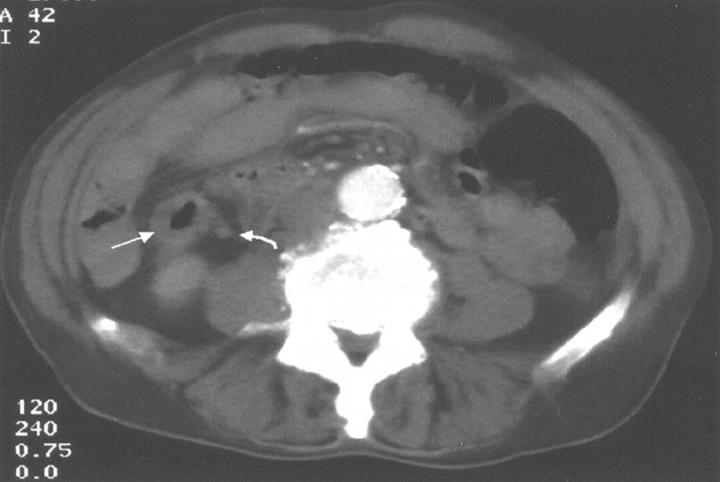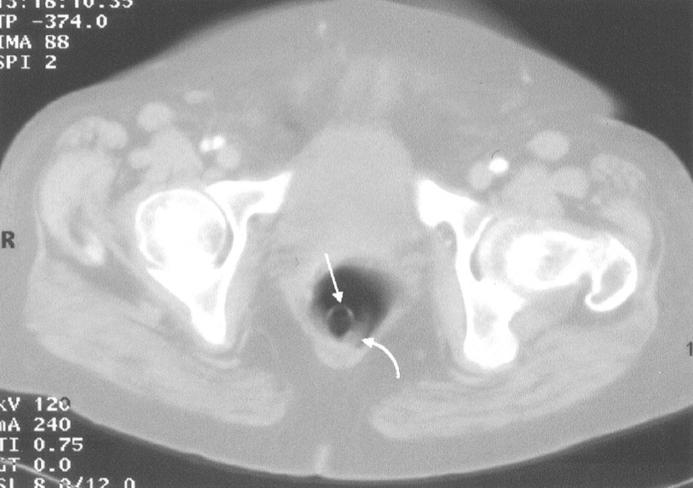Abstract
BACKGROUND AND AIMS—To determine the sensitivity and specificity of computed tomography (CT) pneumocolon in the detection of colorectal neoplasms. METHODS—A total of 201 consecutive patients with colorectal symptoms or requiring surveillance for colorectal neoplasms underwent both conventional colonoscopy and CT pneumocolon. RESULTS—On conventional colonoscopy 13 invasive colorectal carcinomas were detected in 13 patients, and 118 polyps in 63 patients (14 polyps were ⩾1 cm in diameter, 25 were 6-9 mm, and 79 were ⩽5 mm). CT pneumocolon detected all 13 cancers, two false positive cancers, but only 20 polyps (seven were ⩾1 cm). This resulted in a sensitivity of 100% (95% confidence interval (CI) 87-100%) and specificity of 99% (95% CI 97-100%) for detection of invasive carcinoma, and a sensitivity of 73% (95% CI 56-90%) and specificity of 94% (95% CI 91-98%) for detection of invasive carcinoma and/or ⩾1 cm polyps. CT pneumocolon also identified invasive carcinoma not seen at colonoscopy because of incomplete examination in three patients, and detected metastases in six colorectal carcinoma patients and extracolonic carcinoma in a further seven patients. CONCLUSIONS—CT pneumocolon had a high sensitivity and specificity for detection of invasive colorectal carcinoma but not colorectal polyps. CT pneumocolon may be suitable for initial investigation of patients with symptoms of colorectal malignancy. Keywords: computed tomography; colonoscopy; colorectal cancer; colonic polyps
Full Text
The Full Text of this article is available as a PDF (138.3 KB).
Figure 1 .
CT pneumocolon shows circumferential thickening of the colon just below the hepatic flexure (straight arrow) with some irregularity of the outer wall and a small adjacent lymph node (curved arrow). These features are consistent with a colonic cancer on CT. This tumour was not seen on initial colonoscopy because of poor bowel preparation but was confirmed on subsequent colonoscopy.
Figure 2 .
CT pneumocolon at the level of the rectal tube (straight arrow). This patient had a 1 cm rectal polyp seen at conventional colonoscopy but not reported on CT pneumocolon. On retrospective review, the only abnormality detected is shown adjacent to the rectal tube (curved arrow) and is thought to possibly represent the polyp.
Selected References
These references are in PubMed. This may not be the complete list of references from this article.
- Amin Z., Boulos P. B., Lees W. R. Technical report: spiral CT pneumocolon for suspected colonic neoplasms. Clin Radiol. 1996 Jan;51(1):56–61. doi: 10.1016/s0009-9260(96)80221-2. [DOI] [PubMed] [Google Scholar]
- Dachman A. H., Lieberman J., Osnis R. B., Chen S. Y., Hoffmann K. R., Chen C. T., Newmark G. M., McGill J. Small simulated polyps in pig colon: sensitivity of CT virtual colography. Radiology. 1997 May;203(2):427–430. doi: 10.1148/radiology.203.2.9114099. [DOI] [PubMed] [Google Scholar]
- Damore L. J., 2nd, Rantis P. C., Vernava A. M., 3rd, Longo W. E. Colonoscopic perforations. Etiology, diagnosis, and management. Dis Colon Rectum. 1996 Nov;39(11):1308–1314. doi: 10.1007/BF02055129. [DOI] [PubMed] [Google Scholar]
- Fenlon H. M., Nunes D. P., Schroy P. C., 3rd, Barish M. A., Clarke P. D., Ferrucci J. T. A comparison of virtual and conventional colonoscopy for the detection of colorectal polyps. N Engl J Med. 1999 Nov 11;341(20):1496–1503. doi: 10.1056/NEJM199911113412003. [DOI] [PubMed] [Google Scholar]
- Glick S., Wagner J. L., Johnson C. D. Cost-effectiveness of double-contrast barium enema in screening for colorectal cancer. AJR Am J Roentgenol. 1998 Mar;170(3):629–636. doi: 10.2214/ajr.170.3.9490943. [DOI] [PubMed] [Google Scholar]
- Hara A. K., Johnson C. D., Reed J. E., Ahlquist D. A., Nelson H., MacCarty R. L., Harmsen W. S., Ilstrup D. M. Detection of colorectal polyps with CT colography: initial assessment of sensitivity and specificity. Radiology. 1997 Oct;205(1):59–65. doi: 10.1148/radiology.205.1.9314963. [DOI] [PubMed] [Google Scholar]
- Hara A. K., Johnson C. D., Reed J. E., Ehman R. L., Ilstrup D. M. Colorectal polyp detection with CT colography: two- versus three-dimensional techniques. Work in progress. Radiology. 1996 Jul;200(1):49–54. doi: 10.1148/radiology.200.1.8657944. [DOI] [PubMed] [Google Scholar]
- MacCarty R. L. Colorectal cancer: the case for barium enema. Mayo Clin Proc. 1992 Mar;67(3):253–257. doi: 10.1016/s0025-6196(12)60102-5. [DOI] [PubMed] [Google Scholar]
- Rex D. K. CT and MR colography (virtual colonoscopy): status report. J Clin Gastroenterol. 1998 Oct;27(3):199–203. doi: 10.1097/00004836-199810000-00004. [DOI] [PubMed] [Google Scholar]
- Rex D. K., Rahmani E. Y., Haseman J. H., Lemmel G. T., Kaster S., Buckley J. S. Relative sensitivity of colonoscopy and barium enema for detection of colorectal cancer in clinical practice. Gastroenterology. 1997 Jan;112(1):17–23. doi: 10.1016/s0016-5085(97)70213-0. [DOI] [PubMed] [Google Scholar]
- Rex D. K., Vining D., Kopecky K. K. An initial experience with screening for colon polyps using spiral CT with and without CT colography (virtual colonoscopy) Gastrointest Endosc. 1999 Sep;50(3):309–313. doi: 10.1053/ge.1999.v50.97776. [DOI] [PubMed] [Google Scholar]
- Waye J. D. What is a gold standard for colon polyps? Gastroenterology. 1997 Jan;112(1):292–294. doi: 10.1016/s0016-5085(97)70247-6. [DOI] [PubMed] [Google Scholar]




